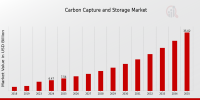(I-AutoNewsWire.com, June 30, 2025 ) Carbon Capture and Storage Market Overview
According to a Comprehensive Research Study by Market Research Future (MRFR), Carbon Capture and Storage Market Information By Technology, Application, End Use, Method, Regional – Forecast till 2035. The Carbon Capture and Storage Market industry is projected to grow from USD 6.47 Billion in 2024 to USD 35 Billion by 2035, exhibiting a compound annual growth rate (CAGR) of 16.6% during the forecast period (2025 – 2035). Carbon Capture and Storage Market Size was valued at USD 5.55 Billion in 2023.
The Carbon Capture and Storage (CCS) market is rapidly evolving as a critical component of global strategies aimed at mitigating climate change. As countries and corporations race to achieve net-zero emissions targets, the role of CCS in reducing greenhouse gas emissions from industrial processes and power generation is gaining widespread recognition.
Request To Free Sample of Report:
rnhttps://www.marketresearchfuture.com/sample_request/1862
Key Companies:
Equinor
ExxonMobil
BP
CCS Institute
Aker Solutions
Shell
Eni
Chevron
Dilbit Energy
Total Energies
Climeworks
Mitsubishi Heavy Industries
Carbon Clean Solutions
Occidental Petroleum
Siemens
Market Dynamics and Growth Drivers
The CCS market operates within a highly dynamic framework shaped by the interplay of regulatory, technological, economic, and environmental factors. Growing emphasis on decarbonization, particularly in hard-to-abate sectors such as cement, steel, and oil & gas, is creating strong demand for carbon capture solutions. Government support through funding, tax credits, and emissions trading systems is making CCS projects more economically viable.
Key Market Drivers
Climate Change Commitments: One of the primary drivers of the CCS market is the global push to limit global warming to well below 2°C, as outlined in the Paris Agreement. Countries are setting increasingly ambitious net-zero emissions targets, many of which are unattainable without large-scale deployment of CCS technologies.
Decarbonizing Industry: Industries such as cement, steel, and petrochemicals are difficult to decarbonize through renewable energy alone. CCS offers one of the few viable pathways to significantly reduce emissions from these sectors without halting operations.
Policy and Regulatory Support: Supportive policies like the U.S. 45Q tax credit, the European Union’s Innovation Fund, and national carbon pricing initiatives are instrumental in encouraging investment in CCS. In particular, the U.S. Inflation Reduction Act of 2022 significantly boosted incentives for carbon capture, positioning the country as a global leader in CCS deployment.
Corporate Sustainability Goals: Many corporations are voluntarily adopting net-zero targets, and CCS provides a means to offset emissions that cannot be eliminated through efficiency or renewables alone. This is driving demand for CCS solutions among private-sector players.
Carbon Capture and Storage Market Segmentation Insights
Carbon Capture and Storage Market Technology Outlook
Post-Combustion Capture
Pre-Combustion Capture
Oxy-Fuel Combustion
Direct Air Capture
Carbon Capture and Storage Market Application Outlook
Power Generation
Industrial Processes
Natural Gas Processing
Transport and Storage
Carbon Capture and Storage Market End Use Outlook
Energy Sector
Manufacturing Sector
Chemical Sector
Healthcare Sector
Carbon Capture and Storage Market Method Outlook
Bioenergy with Carbon Capture and Storage
Mineralization
Enhanced Oil Recovery
Aquifer Storage
Carbon Capture and Storage Market Regional Outlook
North America
Europe
South America
Asia Pacific
Middle East and Africa
Purchase Complete Report:
rnhttps://www.marketresearchfuture.com/checkout?currency=one_user-USD&report_id=1862
Challenges and Market Constraints
High Capital Costs: CCS projects require substantial investment in specialized equipment, infrastructure, and ongoing operations. For many companies, the economics do not currently justify the cost without government support.
Public Perception and Opposition: CCS is sometimes criticized as a “stopgap” that allows continued reliance on fossil fuels. Public opposition to storage sites, driven by concerns about safety and long-term environmental impact, can delay or halt projects.
Policy Uncertainty: Fluctuating government support and unclear long-term regulatory frameworks can create risk for investors. A lack of standardization across international jurisdictions also hampers global project development.
Infrastructure Gaps: CCS requires a well-developed network of capture facilities, pipelines, and storage sites. In many regions, the lack of existing infrastructure poses a barrier to rapid deployment.
Technological Advancements and Innovation
Carbon Capture: Novel solvents, sorbents, and membrane technologies are enhancing the efficiency of CO₂ separation from flue gases. Post-combustion capture is currently the most widely used method, but pre-combustion and oxy-fuel combustion methods are also gaining attention for specific industrial applications.
Carbon Transport: Most CO₂ is currently transported via pipelines, but there is growing interest in ship-based transport for countries without pipeline infrastructure. Innovations in pipeline materials and monitoring technologies are improving the safety and reliability of CO₂ transport.
Carbon Storage: Geological storage in saline aquifers, depleted oil and gas fields, and basalt formations is considered the most secure method. Advances in subsurface modeling, seismic imaging, and real-time monitoring are enhancing the predictability and safety of long-term storage.
Direct Air Capture (DAC): Though still in its early stages, DAC is an emerging segment of the CCS market that captures CO₂ directly from ambient air. Companies like Climeworks and Carbon Engineering are pioneering this technology, which could complement traditional CCS in achieving negative emissions.
Browse In-depth Market Research Report:
rnhttps://www.marketresearchfuture.com/reports/carbon-capture-storage-market-1862
Outlook and Future Trends
CCS Clusters and Hubs: To improve economies of scale and reduce unit costs, countries are developing CCS hubs where multiple emitters can share infrastructure. Examples include the UK’s East Coast Cluster and Norway’s Northern Lights project.
Integration with Hydrogen Production: Blue hydrogen, which is derived from natural gas with carbon capture, is gaining traction as a low-carbon fuel. This is expected to create significant demand for CCS technologies in hydrogen hubs.
Carbon Markets and Trading: The expansion of voluntary and compliance carbon markets is creating financial incentives for CCS. Projects that can demonstrate permanent CO₂ removal are poised to benefit from high-value carbon credits.
International Collaboration: Multinational agreements and public-private partnerships are accelerating CCS deployment. Knowledge sharing and funding initiatives led by organizations like the Clean Energy Ministerial and Mission Innovation are playing key roles.
Related Reports:
Thorium Market: https://www.marketresearchfuture.com/reports/thorium-market-31807
Industrial Electric Boiler Market: https://www.marketresearchfuture.com/reports/industrial-electric-boiler-market-32212
Waste Management Carbon Credit Market: https://www.marketresearchfuture.com/reports/waste-management-carbon-credit-market-33406
Alkylate Gasoline Market: https://www.marketresearchfuture.com/reports/alkylate-gasoline-market-39189
market research future.
Market Research Future
+1 (646) 845 9349
info@marketresearchfuture.com
Source: EmailWire.Com
Source link




